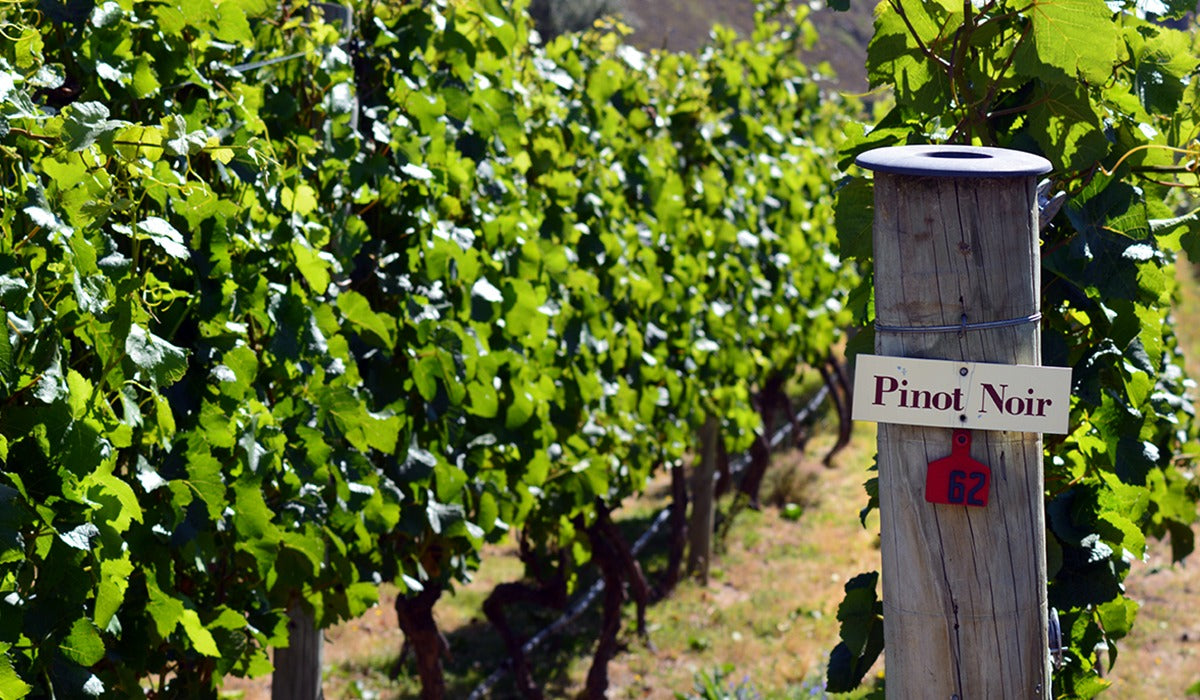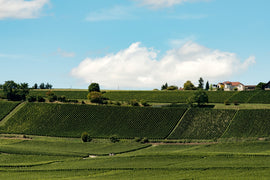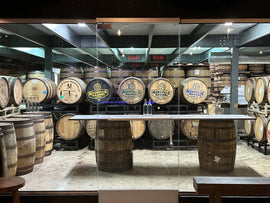Pinot Noir from the Southern Hemisphere
“Pinot Noir” derives from the French words “pine” and “black,” describing the grape’s tight, pine cone-like clusters and dark color. Studies show that Pinot Noir is a very old variety, with origins dating back to the first century AD. It’s believed that the Romans brought the grape with them as they expanded their empire. Pinot Noir is most famously tied to Burgundy, France, where for the better part of a millennium, it has been the source of some of the region's top wines. Even today, the iconic Grand Cru vineyards of the Côte d'Or are synonymous with greatness. The top three highest producing Pinot Noir countries are France, United States and Germany. However, you can find Pinot Noir planted in over 25 different countries, making Pinot Noir a truly internationally acclaimed grape variety.
Pinot Noir is known for its delicate flavors and aromas, which can include notes of red fruit, cherries, and earthy spices. Its flavor and character can be heavily influenced by the terroir in which it is grown, resulting in a wide range of wine styles. This quarter, we decided to feature three Pinot Noirs from the Southern Hemisphere, in the hope of introducing you to a full range of Pinot Noir profiles.
The Pinot Noir grape variety has been in Australia since the early 1800s, when it was brought in by John McArthur in 1817 and James Busby in the 1830s. However, it took time for the grape to find success, and it wasn't until the 1920s that Australian winemaker Maurice O'Shea planted Pinot Noir vines in the Hunter Valley. Today, Pinot Noir is thriving in Australia's cooler regions, such as Tasmania, Yarra Valley, and the Adelaide Hills, as well as in warmer inland regions. Australian Pinot Noir is described as delicate and food-friendly, with flavors of cherries and red berries. It's often used in sparkling wines, but can also be used to make red table wines.
Pinot Noir grapes were first planted in New Zealand in 1819 in the far north of the North Island, but there's no written evidence of this until 1855. Some of the original vines may have come from cuttings from Port Jackson, Australia. In 1889, Mission Vineyards planted Pinot Noir grapes in Hawkes Bay, and William Beetham planted them in Wairarapa.
Interest in Pinot Noir increased again in the 1970s, when Nick Nobilo of Nobilo Wines produced New Zealand's first commercial Pinot Noir since the 1800s in 1973. Other regions also began experimenting with Pinot Noir, including Martinborough in 1979 and Central Otago in 1987. Today, Pinot Noir is New Zealand's second most planted grape variety, after Sauvignon Blanc, and is often associated with the country's finest wines. One of the reasons New Zealand Pinot Noir is considered premium quality is the "Abel" clone, which is said to have originated from a cutting taken from the Domaine de la Romanée-Conti vineyards in Burgundy. A tourist allegedly smuggled the cutting into New Zealand in a gumboot and it was intercepted by Malcolm Abel, a local winemaker and customs officer, at Auckland airport. Abel sent the vine to the government's viticultural research center for processing and then planted the first cuttings. The Abel clone is the foundation for many of New Zealand's most sought-after Pinot Noirs.
Pinot Noir's history in Argentina is relatively short, with the first plantings taking place in the 1960s. The grapes were primarily used to make sparkling wines, and by the 1950s, more than 4,000 acres in Patagonia were planted with Pinot Noir. However, by 2000, that number had dropped to less than 500 acres. Piero Incisa della Rocchetta of Bodega Chacra helped put Argentina on the map for Pinot Noir in the early 2000s by using grapes from an old vineyard in Patagonia. This inspired other producers to look for old vineyards or clones that would work better in Argentina's terroirs, and to identify regions where Pinot Noir would thrive. Today, Pinot Noir is grown in more regions of Argentina than Malbec, and the country's surface area under vine with Pinot Noir has almost doubled in the last two decades.
Cheers!
Carrie Upson-General Manager and Wine Buyer
|
Burn Cottage “Moonlight Race” Pinot Noir |
|
|
Region / Country of Origin: Central Otago, New Zealand |
About the winery: Burn Cottage is a 28-hectare vineyard, farm, and estate in the foothills of the Pisa range in Central Otago, New Zealand. The vineyard is owned by husband and wife Marquis & Dianne Sauvage, who purchased the unplanted property in 2002. It had been grazed by sheep for as long as can currently be remembered. There were, and are, no immediate vineyard neighbors. The site is quite coveted in the region, for it is sheltered from both northerly and southerly winds by large hills and forms a beautiful, protected bowl much like a modern amphitheater. It is a phenomenal site for Pinot Noir; with warm summers and cold winters, there is plenty of sunshine with particularly long warm days through the growing season and cool nights that help achieve ripeness while retaining good acidity. About the Vineyards: Like Ted’s property at Littorai, Burn Cottage is a fully functional farm, with 10 hectares under vine and the rest of the land devoted to cattle, chickens, beehives, olive groves, and other native species of New Zealand plants, bushes, and trees. They also produce their own compost and grow many of the preparations needed for biodynamic farming. At Burn Cottage, they believe that biodiversity is the cornerstone of healthy farming – and that great wines are not made from fruit but are born of the soils which nurture the vines and then made with minimal intervention. Tasting Notes: “The 2022 Moonlight Race Pinot Noir is supple and spicy, with pink peppercorn, cherry blossom, red apple skins, a hint of blond tobacco and white pepper. The wine is light in the glass (but vibrant) and the tannins suit it—they are totally fresh and fine—finely milled and like poudre. Superb, silky, totally satisfying and enlivening.” 94 Points WA |
|
Winemaker: Claire Mulholland |
|
|
Price per bottle / Price per case: $46.99 btl/ $507.49 case |
|
|
Suggested Food Pairing: Game birds such as quail, turkey and duck, Filet of New Zealand salmon, Mushroom risotto, Roast pork with cherry gastrique |
|
|
Moorooduc Estate Pinot Noir 2018 |
|
|
Region / Country of Origin: Mornington Peninsula, Victoria, Australia |
About the winery: Established in 1982 by Richard and Jill McIntyre, Moorooduc Estate is a small, family run wine business that has developed an enviable reputation for complex and food friendly wines. Moorooduc Estate's philosophy in everything they do is to make the most of top quality ingredients. Intensive, hands-on care in the vineyard, with minimal use of chemicals, produces the best possible fruit for their wines. Wild yeast ferments and minimal intervention winemaking, with a nod to traditional Burgundian techniques, allow the wines to express their site specificity, or terroir. Similarly, they aim to source ingredients for the food they serve that are seasonal, local and organic. About the winemaking: All the wines are made on-site in the Rammed Earth Winery. From a very modest 20 tonne winery set up in 1987, they now have a more sophisticated facility with a small but high-quality Bucher press and an excellent Vaslin – Bucher destemmer. Since 2006 they have had the facility to chill fruit in a refrigerated shipping container which has been particularly beneficial with the warmer climate and earlier vintages we have been experiencing over recent years. In the winery, the emphasis is on gentle winemaking methods with some quality control where they believe this is important. Tasting Notes: “Mornington Peninsula is synonymous with Pinot and Moorooduc is one of the region’s top producers. The color of rose petals and bricks, the ’18 vintage is in a lovely place. It’s aromatic and expressive, with potpourri-like aromas of dried red berries, crushed flower petals and spice that knit seamlessly together. They’re underpinned by earthy, autumnal nuances. The ethereal palate comes with a beautiful tang of acidity. It’s framed by ultra-fine, chiseled tannins, which leave room for the delicate red fruit, floral and spice flavors that linger on the lengthy finish.” 94 Points WE |
|
Winemaker: Dr. Richard McIntyre |
|
|
Price per bottle / Price per case: $39.99 btl/ $431.89 case |
|
|
Suggested Food Pairing: Slow cooked duck marylands with beetroot and potato mash, Eggplant parmesan, Baked brie with rosemary, Roast lamb |
|
Chacra “Barda” Pinot Noir |
|
|
Region / Country of Origin: Patagonia, Argentina |
About the winery: Bodega Chacra is located in the Rio Negro Valley of northern Patagonia, 620 miles south of Buenos Aires, 1,240 miles north of Tierra del Fuego, and roughly equidistant west to east from the Andes Mountains and the Atlantic Ocean. The property's situation in the arid central Argentine desert is tempered by the confluence of the Neuquen and Limay Rivers, both of which flow from the Andes and converge in the Rio Negro, which in turn flows into the Atlantic. The Rio Negro Valley itself is a glacial bed 15.5 miles wide, stretching 310 miles along the river's banks at an elevation of 750 feet above sea level. The valley is irrigated by a network of channels excavated in the late 1820s by British colonists who observed the abundant snow melt flowing from the Andes and created an oasis in the middle of the desert. About the Winemaking: 24% in french oak barrels, (5% new), 41% in concrete tanks and 35% in stainless steel tanks for 8 months. Tasting Notes: Pure, minerally and powerful, with concentrated flavors of red plum and dried raspberry, loaded with powerful meaty notes. Sandalwood accents linger on the finish, showing caressing tannins. “Acidic red berries, fresh raspberries, chalk and a hint of herbal freshness. Crunchy and fresh, full of verve. Transparent and nimble with soft, round tannins and a bright, linear finish.” 93 JS |
|
Winemaker: Piero Incisa della Rocchetta |
|
|
Price per bottle / Price per case: $37.99 btl/$410.29 case |
|
|
Suggested Food Pairing: A perfect pairing for fish, salads and omelets |
|





